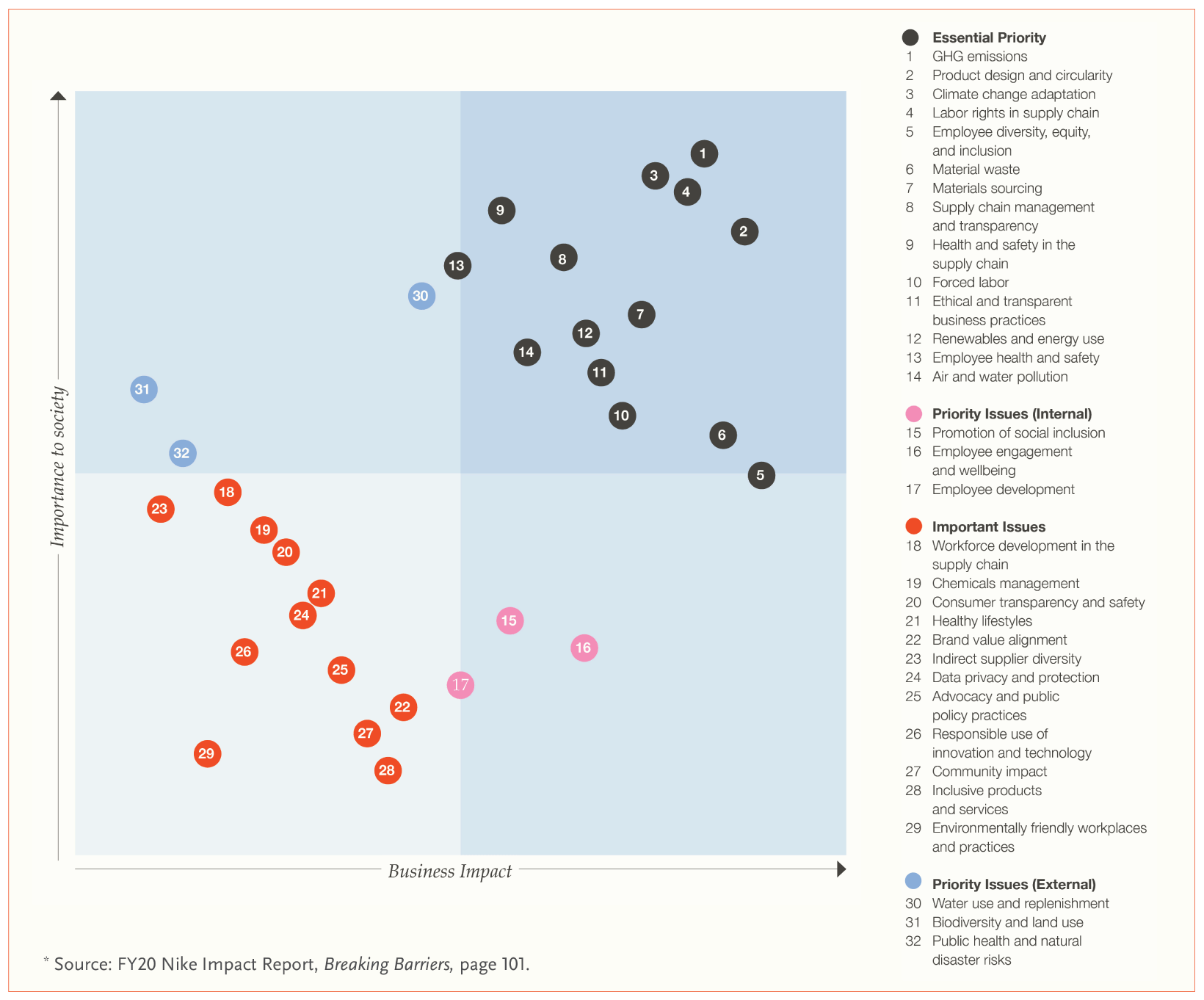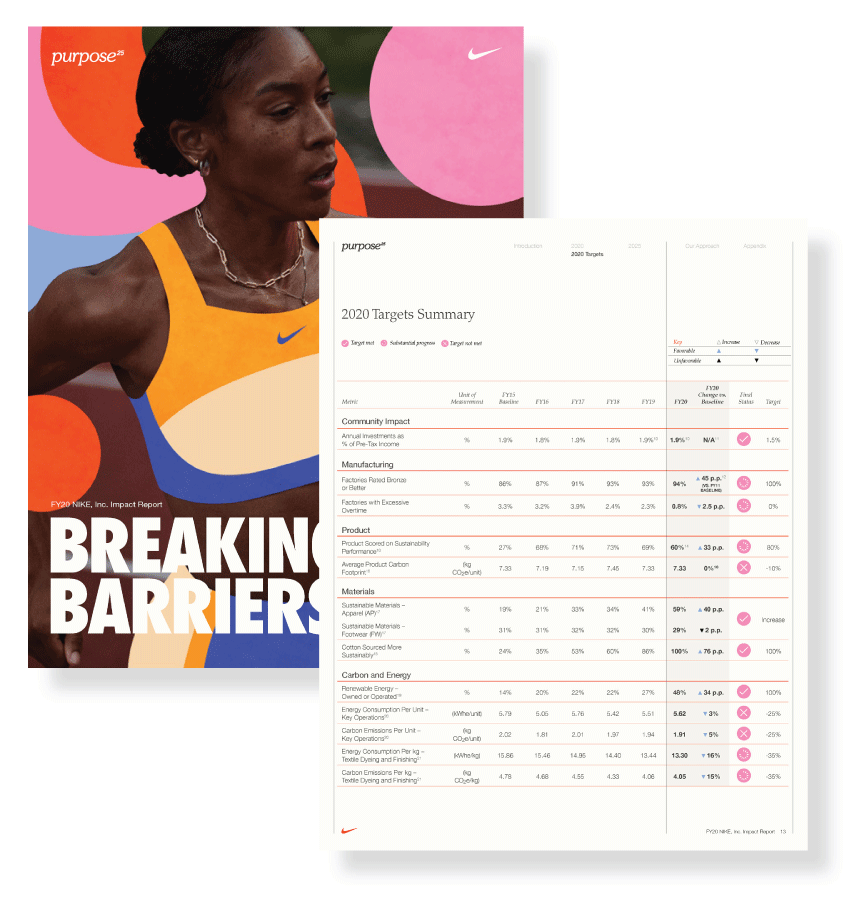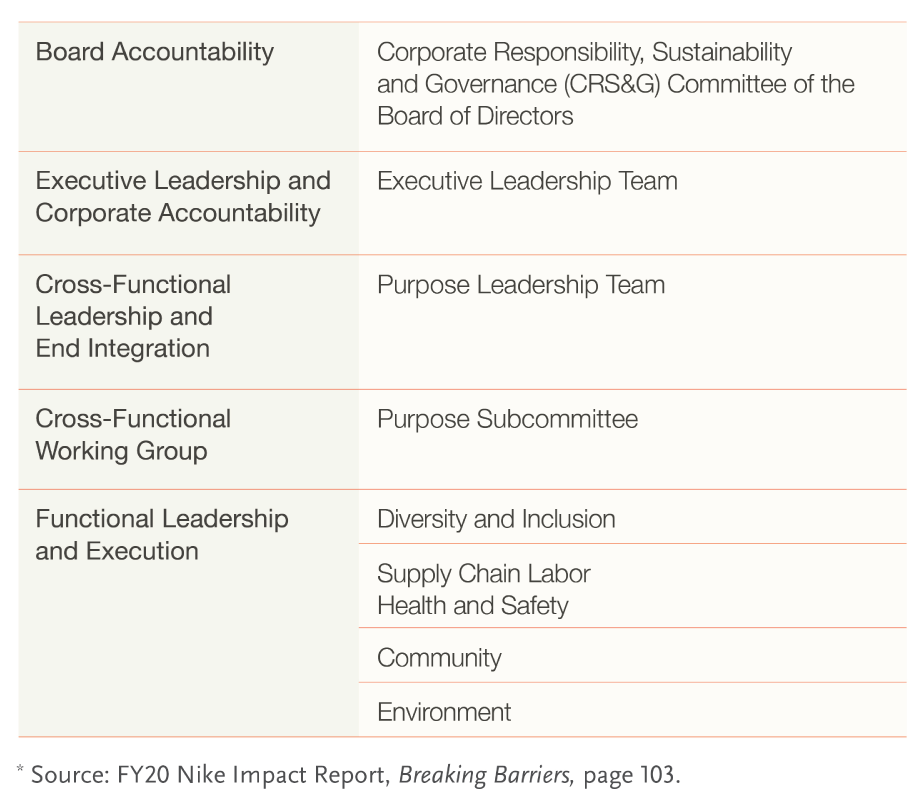Our Corporate Responsibility, Sustainability and Governance Committee oversees our sustainability strategy, and we provide it visibility to that strategy and our execution against it with a scorecard on our progress at every meeting, discussing certain topics at every meeting, as well as more in-depth presentations twice per year.”
So, how did you work with the board to define Nike’s “purpose governance structure” and the core elements of the company’s efforts? How did you decide what would be included and what would not?
When I stepped into this role a little over three years ago, we had two major objectives:
-
Define quantitative, measurable sustainability goals for the next 5 years.
-
Architect an offense that encouraged the integration of purpose across the company.
Our Corporate Responsibility, Sustainability and Governance Committee provided oversight and feedback as we benchmarked, evaluated and debated how best to achieve both of those goals. The committee members’ perspectives and experiences provided excellent context as we worked through the evolution of our offense and sharpened our internal perspective.
As we started to refine the specifics of our net set of goals, we had several reviews with the committee, which provided great insight that helped land us in a place that we are very proud of.
NIKE FY20 PRIORITY ISSUES*

Click to enlarge
How will you communicate your progress in these areas to Nike’s shareholders and other stakeholders?
The Nike Impact report is instrumental in that regard. It effectively serves as our “report card” to our stakeholders — and I mean that in the broadest sense of the word. It’s the platform we use to communicate about our sustainability efforts and progress to our investors and shareholders, employees and outside stakeholders.

Click to enlarge
We normally will have specific engagement strategies that are more in depth with each of those constituencies as well.
Our CRS&G Committee oversees our sustainability strategy, and we provide it visibility to that strategy and our execution against it with a scorecard on our progress at every meeting, discussing certain topics at every meeting, as well as more in-depth presentations twice per year. We also hold a semi-annual, in-depth update with our board to share progress and challenges on all purpose targets.
What lessons learned can you share for other boards who are considering their role in sustainability? Many companies and boards are in the earlier stages of their journey on ESG issues and oversight. What advice do you have for boards that are in the early stages?
As you know, the board’s core duty is oversight of the company. That oversight is inclusive of today’s strategy and execution as well as looking forward. For example, our board anticipated the confluence of corporate responsibility and sustainability with corporate governance issues, and combined the Corporate Responsibility Committee with the Nominating and Governance Committee in 2017 to form a single committee to oversee ESG issues and purpose at Nike. Establishing a structure that allows the board to effectively oversee and have visibility into sustainability is important.
If a company is just starting this journey, I’d advise them to really identify what you want to stand for in this space. What makes this authentic and meaningful to your company? It’s the right thing to do, but understanding your impact and where you can drive real change is critical. A few fundamental questions that will help define a strategy that leads to impact include:
-
What are the biggest sources of impact we have as a company?
-
Where are the levers that we control most directly?
-
What trade-offs might we need to make to drive results?
-
Where are the intersections of incentive that will drive both business and sustainability results (because being more sustainable often means being more operationally efficient and resilient)?
The answers to these questions often lead to very clear and specific areas of focus that become the basis for the strategy.
Finally, you must operationalize the strategy. It has to be integrated across the organization with each major function of the company having a clear and specific accountability that drives the enterprise wide ambition. And, as management puts this strategy and operation in place, it’s important to implement a structure such that both current and future strategies are overseen by the board.
PURPOSE GOVERNANCE AT NIKE*

What’s next for Nike in sustainability?
We will continue to innovate and scale solutions in service of the planet and drive momentum across the enterprise. We have ambitious, science-based targets that won’t be easy to achieve, and it will require the entire company staying focused for the long term. Our connection to the consumer will also become increasingly robust as we accelerate and scale new, more sustainable products and services and create compelling engagement opportunities across our online and offline retail platforms.
How do you envision the board contributing to that future?
Our Board and the CRS&G committee will continue to oversee our work and be an important source of guidance for us in these efforts. We are fortunate to have some incredibly experienced and talented individuals on our Board — some of the best in the world at their jobs. So I am grateful that I have them as a resource to help guide our growth and progress.
Finally, why do this at all? How is Nike a better company for your efforts?
That’s a great question. Frankly, we’ve been at it for so long, it has become second nature. But the reality is that climate change is an existential threat to sport… something we happen to care a lot about. We have a unique role to play in showing the urgency of the issue but importantly, what is possible.
Progress and positive change is possible at the enterprise level and we will only accelerate that if we work together.
